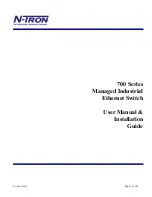
124
Transmit traffic through a router will be load balanced as transmit load balancing is based on the
source and destination IP address and TCP/UDP port number. Since routers do not alter the source
and destination IP address, the load balancing algorithm works as intended.
Configuring routers for Hot Standby Routing Protocol (HSRP) does not allow for receive load
balancing to occur in the adapter team. In general, HSRP allows for two routers to act as one router,
advertising a virtual IP and virtual MAC address. One physical router is the active interface while the
other is standby. Although HSRP can also load share nodes (using different default gateways on the
host nodes) across multiple routers in HSRP groups, it always points to the primary MAC address of
the team.
SLB (Auto-Fallback Disable)
This type of team is identical to the Smart Load Balance and Failover type of team, with the
following exception-when the standby member is active, if a primary member comes back on line,
the team continues using the standby member rather than switching back to the primary member. This
type of team is supported only for situations in which the network cable is disconnected and
reconnected to the network adapter. It is not supported for situations in which the adapter is removed/
installed through Device Manager or Hot-Plug PCI.
If any primary adapter assigned to a team is disabled, the team functions as a Smart Load Balancing
and Failover type of team in which auto-fallback occurs.
Link Aggregation (IEEE 802.3ad LACP)
Link Aggregation is similar to Generic Trunking except that it uses the Link Aggregation Control
Protocol to negotiate the ports that will make up the team. LACP must be enabled at both ends of the
link for the team to be operational. If LACP is not available at both ends of the link, 802.3ad provides
a manual aggregation that only requires both ends of the link to be in a link up state. Because manual
aggregation provides for the activation of a member link without performing the LACP message
exchanges, it should not be considered as reliable and robust as an LACP negotiated link. LACP
automatically determines which member links can be aggregated and then aggregates them. It
provides for the controlled addition and removal of physical links for the link aggregation so that no
frames are lost or duplicated. The removal of aggregate link members is provided by the marker
protocol that can be optionally enabled for Link Aggregation Control Protocol (LACP) enabled
aggregate links.
The Link Aggregation group advertises a single MAC address for all the ports in the trunk. The MAC
address of the Aggregator can be the MAC addresses of one of the MACs that make up the group.
LACP and marker protocols use a multicast destination address.
The Link Aggregation control function determines which links may be aggregated and then binds the
ports to an Aggregator function in the system and monitors conditions to determine if a change in the
aggregation group is required. Link aggregation combines the individual capacity of multiple links to
form a high performance virtual link. The failure or replacement of a link in an LACP trunk will not
cause loss of connectivity. The traffic will simply be failed over to the remaining links in the trunk.
`
Link aggregation is not supported in the Blade Server.
















































